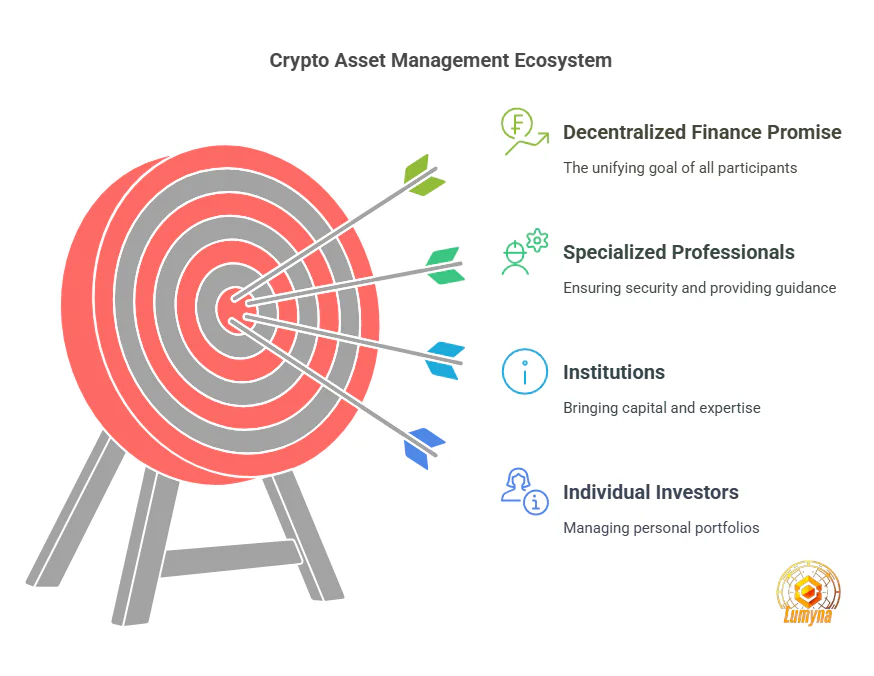Over the past decade, cryptocurrencies have transformed from a niche experiment into a global financial phenomenon. Bitcoin’s debut in 2009 sparked a revolution, followed by thousands of digital assets like Ethereum and stablecoins, driving a market now worth trillions.
As adoption increases, among individuals, institutions, and even governments, the complexity of owning and profiting from these assets has grown.
This is where crypto asset management comes in: a structured approach to navigating the volatile, decentralized world of digital wealth.
Whether you’re a beginner getting started into Bitcoin, an investor building a diverse portfolio, or an enthusiast curious about the future, this guide aims to deliver practical clarity on managing crypto effectively in today’s dynamic landscape.
Who is Involved in Cryptocurrency Asset Management?
Crypto asset management involves a diverse cast of participants, each playing a unique role in the ecosystem. At the individual level, retail investors, traders, and crypto enthusiasts are key players.

These individuals manage personal portfolios, often juggling assets like Bitcoin and Ethereum to grow their wealth or experiment with new tokens.
Their involvement ranges from casual hodlers—those who buy and hold—to active day traders seeking short-term gains.
On a larger scale, institutions have entered the fray, bringing significant capital and expertise. Hedge funds, asset management firms, and corporations now invest in crypto, viewing it as a hedge against inflation or a high-return opportunity. For example, companies like BlackRock and Fidelity have launched crypto-focused funds, signaling a shift toward mainstream acceptance.
Beyond these groups, specialized professionals keep the system running smoothly. Crypto custodians safeguard digital assets, ensuring they’re secure from hacks, while portfolio managers design strategies to optimize returns. Financial advisors with blockchain expertise guide clients through this complex market.
According to a 2023 PwC report, institutional adoption of crypto grew by 40% in just two years, underscoring the rapid professionalization of the space. From solo traders to Wall Street giants, crypto asset management spans a wide range of participants.
LUMYNA MEDIA
Whether it’s an individual securing a hardware wallet or a hedge fund allocating millions, the who of crypto management reflects a broad, evolving community united by the promise of decentralized finance.
What is Crypto Asset Management?
Crypto asset management is the process of overseeing, investing, and securing digital assets such as Bitcoin, Ethereum, and a vast array of altcoins.
It’s a systematic approach to handling the unique opportunities and challenges presented by cryptocurrencies. At its core, this involves several key components. Portfolio diversification ensures a balanced mix of assets—for instance, combining Bitcoin’s stability, Ethereum’s innovation, and stablecoins’ predictability to mitigate losses.
Risk assessment is important, requiring careful analysis of market volatility, which can see prices soar or plummet within hours.
Security measures are equally vital, with tools like cold storage (offline devices) and multi-signature wallets protecting assets from cyber threats.
Unlike traditional asset management, which deals with stocks, bonds, and real estate under centralized oversight, crypto asset management operates in a decentralized ecosystem powered by blockchain technology.
This reliance on distributed ledgers means no single authority governs the assets, offering both freedom and complexity.
Additionally, the crypto market never sleeps, providing 24/7 access that contrasts with the regulated hours of traditional exchanges. The global crypto market cap, reaching an estimated $2.5 trillion in early 2025 based on current growth trends, highlights the scale of this new frontier.
Imagine a financial advisor for your digital wealth, but instead of stocks, they’re juggling blockchain-based tokens—each with its own risks and rewards.
This narrative captures the essence of crypto asset management: a blend of strategy, technology, and vigilance tailored to a borderless, fast-evolving domain. It’s not just about holding crypto; it’s about making it work smarter and safer in a world unbound by traditional rules..
When Did Crypto Asset Management Emerge?
The story of crypto asset management begins with Bitcoin’s launch in 2009, marking the genesis of crypto assets.
Created by the mysterious Satoshi Nakamoto, Bitcoin introduced a decentralized digital currency that challenged traditional finance, laying the groundwork for what would become a trillion-dollar ecosystem.
Early adopters managed their holdings informally, but the need for structured oversight grew over time.
Between 2013 and 2017, the rise of altcoins like Ethereum and the initial coin offering (ICO) craze expanded the market, making portfolios more complex.
By 2020, the decentralized finance (DeFi) boom introduced new ways to earn and invest, further demanding sophisticated management strategies.
A key milestone arrived in 2021 with the introduction of crypto exchange-traded funds (ETFs), signaling mainstream recognition and the need for professional management. Institutional entry accelerated from 2021 to 2025, as firms like Fidelity and Goldman Sachs embraced crypto. Crypto asset management wasn’t a thing until Bitcoin proved digital money could thrive.
Here’s a quick timeline:
- 2009: Bitcoin begins.
- 2017: ICO craze sparks portfolio complexity.
- 2025: Professional management becomes standard.
Today, crypto asset management is an established practice, evolving alongside the assets it governs
From physical hubs to virtual networks, crypto asset management thrives wherever innovation and opportunity converge.
Where Does It Happen?
Crypto asset management unfolds across both physical and digital landscapes, reflecting its global, decentralized nature. Geographically, certain hubs stand out as crypto-friendly regions.
The U.S. drives innovation with its tech giants and regulatory debates, while Singapore offers a stable, pro-business environment.
Switzerland, a leader in blockchain adoption, hosts over 900 blockchain companies as of 2024, earning its nickname “Crypto Valley.”
The UAE, with cities like Dubai, attracts investors through tax incentives and forward-thinking policies. Yet, the true action happens online.
Digital spaces like crypto exchanges—think Binance or Coinbase—serve as bustling marketplaces for trading and management. DeFi platforms, such as Aave or Compound, enable decentralized investing, while wallet providers offer tools to store and track assets.
Whether it’s a sleek office in Zurich or a decentralized app on your phone, crypto management is borderless.
Here’s where it takes shape:
- Centralized platforms: Custodial services like Gemini handle security and compliance.
- Decentralized ecosystems: Protocols like Uniswap empower peer-to-peer management.
- Offline: Hardware wallets like Ledger keep assets safe from digital threats.
Why is Cryptocurrency Asset Management Important?
Crypto asset management is essential because the cryptocurrency market is a high-stakes arena where fortunes can shift overnight. Volatility is a defining feature—crypto prices can swing 20% in a single day, demanding active oversight to protect investments.
A sudden drop in Bitcoin’s value or a meme coin’s meteoric rise can catch the unprepared off guard, making strategic management a necessity. Security adds another layer of urgency.
High-profile hacks, like the 2014 Mt. Gox incident that saw 850,000 BTC stolen, underscore the risks of lax protection. Without robust measures, digital assets remain vulnerable to theft or loss.
Meanwhile, the market’s growth potential fuels its appeal. Early adopters and seasoned investors alike aim to maximize returns as crypto matures into a mainstream asset class, but this requires careful planning to capitalize on opportunities.
Without management, your crypto could vanish in a hack or a bad trade. Here’s why it matters:
- Mitigates risk from market crashes: Diversification and timing can soften the blow of downturns.
- Ensures compliance with evolving regulations: As governments tighten rules, proper management keeps you legal.
- Optimizes long-term investment strategies: Balancing risk and reward builds sustainable wealth.
Crypto asset management isn’t just a luxury—it’s a shield against chaos and a tool to unlock the market’s promise. In a space this dynamic, staying proactive is the key to survival and success.
How Does Crypto Asset Management Work?
Crypto asset management operates through a deliberate, step-by-step process designed to turn a chaotic market into a structured opportunity. First comes asset selection: choosing cryptocurrencies based on specific goals.
An investor seeking growth might pick Bitcoin or Ethereum, while someone prioritizing stability could opt for stablecoins like USDT. Next is storage, where security is paramount.
Options include secure wallets—such as hardware devices kept offline—or custodial services that handle safekeeping for a fee. Monitoring follows, with investors tracking performance using tools like CoinGecko or portfolio trackers to stay informed about price shifts and trends.
Finally, rebalancing ensures the portfolio adapts to market changes, like selling an overperforming altcoin or buying more of an underweighted asset to maintain balance.
The process is supported by an array of tools.
Smart contracts, especially in DeFi, automate tasks like yield farming or lending.
A 2024 survey revealed that over 60% of crypto investors rely on automated tools and robo advisors for management, highlighting their growing role. It’s like tending a garden—plant the right seeds, prune when needed, and watch it grow.
Start with a mix of assets suited to your risk tolerance, secure them against threats, monitor their progress daily, and adjust as the market shifts. This methodical approach transforms crypto’s wild swings into a manageable ecosystem.
Whether you’re a hands-on trader or delegate to professionals, crypto asset management blends technology and strategy to cultivate wealth. It’s not about luck; it’s about consistent care in a digital landscape that rewards the prepared.
Related Questions on Crypto Asset Management
What are the best cryptocurrency asset management tools?
Popular options include CoinStats and Altrady for individual investors, offering real-time tracking and portfolio insights, while institutional-grade platforms like BitGo provide advanced security and compliance features for larger players.
Is cryptocurrency asset management safe?
Yes, it can be safe if proper security measures, such as cold storage, and reputable providers are used to safeguard assets against hacks and losses.
How much does cryptocurrency asset management cost?
Fees vary—DIY tools may charge as little as 0.5% of assets, while professional services typically range from 2-3% annually, depending on the level of support and complexity.
Can I manage crypto assets myself?
Absolutely, self-management is possible and common, though it requires time, technical knowledge, and awareness of risks like market volatility or phishing scams.
What’s the future of crypto asset management?
By 2030, expect greater AI integration for predictive analytics, clearer regulations to stabilize the market, and more institutional-grade tools as adoption expands.
Conclusion
Cryptocurrency asset management is a structured approach to navigating the wild world of digital wealth, bringing order to a market known for its volatility and opportunity.
From individual enthusiasts balancing Bitcoin and altcoins to institutions deploying millions through sophisticated strategies, it’s a discipline that adapts to diverse needs.
This article has explored the who, what, when, where, why, and how of managing crypto, revealing a practice that’s as dynamic as the assets themselves. Whether you’re a beginner testing the waters or a pro refining your portfolio, the time to act is now—start exploring management options today.
Tools, custodians, and self-directed strategies await, each offering a path to harness crypto’s potential. As crypto matures, so must the way we handle it—management is the key to unlocking its full promise, ensuring that digital wealth thrives in an ever-evolving landscape.

